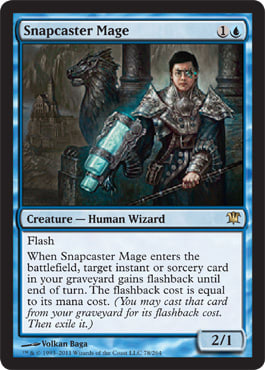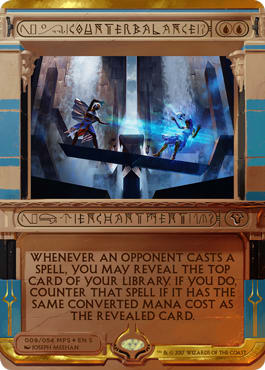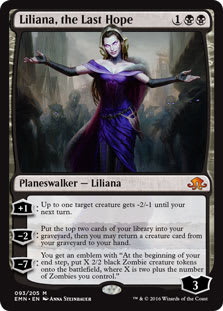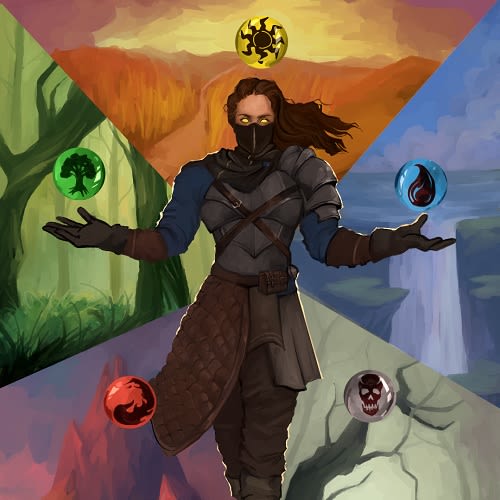As you all may well know, I’ll find just about any excuse to write about my favorite format, the Cadillac of tournament Magic, Legacy. The results from the recent Eternal Extravaganza in Baltimore are barely enough to justify a whole new article dissecting the format, but there are a lot of interesting trends going on under the hood that merit discussion and analysis. Of course, I’m just ready to drool over some sweet new tech and some value-oriented decklists!
We’ll start by identifying some macro-trends and how the best-finishing decks from the recent tournament reflect those trends. Of course, Baltimore (and the Mid-Atlantic in general) is always huge on Legacy, so it makes perfect sense that the true cream of the crop would rise to the top in this large independent tournament.
1: Fatal Push has redefined the removal constraints on the format.
As I’m sure you all have heard repeatedly by now, the specific set of cheap, flexible removal is one of the defining pieces of any format. Whether it’s Harnessed Lightning in current Standard, Lightning Bolt, Dismember, Terminate, and Path to Exile in pre-Fatal Push Modern, or Swords to Plowshares, Abrupt Decay, and now Fatal Push in current Legacy, the one-mana removal (and some of the best two-mana removal) basically outlines which creatures are good and which ones are removal spell magnets waiting to lose you tempo. Before Fatal Push, Tarmogoyf was excellent in Legacy. Aside from Swords to Plowshares out of Miracles, Death and Taxes, and some Stoneblade variants, no deck had a consistent, painless way of killing a Tarmogoyf for less mana than the ‘goyf itself cost. Most fair Blue decks (read: Delver decks) packed a quartet of Lightning Bolts as the primary removal spell/reach spell, with occasional forays into Abrupt Decay for the Sultai or Four-Color variants. This meant that Tarmogoyf (and Gurmag Angler, though not necessarily as a four-of) were large and in-charge in the vast majority of games in which they resolved. Decks warped to try and handle these beefcakes, but Tarmogoyf reigned supreme as one of the preeminent threats of Legacy, the last holdout of an ostensibly “fair” creature, just a straight-up exchange of high power and toughness for only two mana and a card.
Those days are over. Fatal Push has pushed not only Tarmogoyf out of Legacy as a top-tier creature, but it has pushed up hard against Delver of Secrets’ metagame share to a small extent as well. Waiting patiently in the wings, ready to catch that excess metagame percentage, lies my favorite card of all time, the best friend of any one-mana removal spell, the inimitable Snapcaster Mage. Every time a new one-mana removal spell is printed, Snapcaster Mage grows that much more powerful, because one of the easiest ways to win against a fair deck is by sequencing a one-mana removal spell into a Snapcaster+flashback on the third or fourth turn. Answering your opponent’s Deathrite Shaman and Tarmogoyf, for example, while gaining a residual 2/1 body is a great way to glide to a fast win. Now that Snapcaster Mage can come down and answer a Tarmogoyf for only 3 mana from the midrange Sultai decks, it just doesn’t seem like the right time to be casting the best two-mana Green creature ever printed. So what does that mean for the rest of the format?
2: The new face of fair decks is Four-Color Midrange (colorfully called “Czech Pile”)
Four-Color Midrange ? Legacy | Kevin King
- Creatures (13)
- 1 Vendilion Clique
- 4 Baleful Strix
- 4 Deathrite Shaman
- 4 Snapcaster Mage
- Planeswalkers (3)
- 1 Liliana of the Veil
- 2 Jace, the Mind Sculptor
- Instants (19)
- 2 Abrupt Decay
- 2 Counterspell
- 2 Kolaghan's Command
- 2 Spell Snare
- 3 Fatal Push
- 4 Brainstorm
- 4 Force of Will
- Sorceries (5)
- 1 Night's Whisper
- 4 Ponder
- Lands (20)
- 1 Island
- 1 Swamp
- 1 Badlands
- 1 Misty Rainforest
- 2 Tropical Island
- 2 Volcanic Island
- 4 Polluted Delta
- 4 Scalding Tarn
- 4 Underground Sea
- Sideboard (15)
- 1 Abrupt Decay
- 2 Diabolic Edict
- 1 Engineered Explosives
- 1 Fatal Push
- 1 Flusterstorm
- 1 Invasive Surgery
- 1 Leovold, Emissary of Trest
- 2 Pyroblast
- 2 Surgical Extraction
- 2 Thoughtseize
- 1 Vendilion Clique
I’m using Kevin King’s version of the deck from a recent local tournament, because I like his list quite a bit, but there were two copies of the same archetype in the top 8 of the recent Eternal Extravaganza, which bodes well for the rising archetype of Legacy.
Now, to be absolutely clear, I love me a slower version of a Delver of Secrets deck, don’t get me wrong. When I first saw the Czech Pile, I was skeptical. “How in the world does this deck ever beat a combo deck? There’s no pressure in this deck, it’s just a giant pile of value creatures!” The thing that people haven’t caught on to yet is that the sideboard of Four-Color Midrange can be tailored to turn the deck post-sideboard into any deck’s worst nightmare. Snapcaster Mage puts in huge work here, flashing back Fatal Pushes and Counterspells with equal joy against aggro or combo decks, respectively. The inclusion of a number of Abrupt Decays is merely there to ensure that the deck doesn’t just bite the dust to a Counterbalance lock, but the deck is consistent, powerful, and extremely hard to grind out. The Snapcaster Mages, Brainstorms and Ponders mean that each and every sideboard card is magnified in impact, making a two-of look like a four-of in a “normal” deck’s sideboard.
Compare this to a deck like Shardless Sultai, where instead of Snapcaster Mages, the deck plays Shardless Agent and Ancestral Visions. Where Shardless Agent reduces your options for powerful answers, Snapcaster Mage amplifies them. You can’t play Counterspell or Flusterstorm effectively in a Shardless Agent deck, but two Flusterstorms are perfect companions to Snapcaster Mage to profitably answer Storm or Show and Tell decks. Not to mention the fact that Fatal Push is often a bad cascade for a Shardless Agent, while the Snapcaster Mage decks can play a virtual seven copies against the fair matchups, and Brainstorm those dead Pushes away against unfair decks. Also, consider that Shardless Agent into Tarmogoyf is one of the better cascades for Shardless Sultai, and Tarmogoyf isn’t even good in Legacy anymore! It’s true, Four-Color Midrange is simply more advanced than Shardless Sultai, and I expect to see tons of innovation in Snapcaster Mage decks while Shardless Agent sulks on the sidelines. Flashback > Cascade, boys and girls!
The only problem is that the mana base on this puppy is kind of soft to Wasteland and Blood Moon, which leads me to the newest version of the fair(ish) Blue deck that doesn’t fear either of those cards, the boogeyman of the format, Miracles.
3: The new face of Miracles is ready to combat the rise in Abrupt Decay midrange.
Bob Huang and Anuraag Das met in the finals of Eternal Extravaganza with very similar Miracles lists, with a few more one-ofs than normal and the exclusion of the once-ubiquitous Monastery Mentor. Let’s have a look at the newest, grindiest version of Miracles yet.
Miracles ? Legacy | Ben Friedman
- Creatures (3)
- 3 Snapcaster Mage
- Planeswalkers (2)
- 2 Jace, the Mind Sculptor
- Instants (16)
- 1 Counterspell
- 3 Predict
- 4 Brainstorm
- 4 Force of Will
- 4 Swords to Plowshares
- Sorceries (11)
- 1 Council's Judgment
- 2 Entreat the Angels
- 4 Ponder
- 4 Terminus
- Enchantments (3)
- 3 Counterbalance
- Artifacts (5)
- 1 Engineered Explosives
- 4 Sensei's Divining Top
- Lands (20)
- 2 Plains
- 4 Island
- 1 Arid Mesa
- 2 Volcanic Island
- 3 Tundra
- 4 Flooded Strand
- 4 Scalding Tarn
- Sideboard (15)
- 1 Engineered Explosives
- 1 Snapcaster Mage
- 1 Containment Priest
- 2 Pyroblast
- 1 Wear // Tear
- 3 Flusterstorm
- 2 Red Elemental Blast
- 1 From the Ashes
- 2 Surgical Extraction
- 1 Mountain
Snapcaster Mage rears his ugly head again, with the actual best card selection available in the whole format. Brainstorm. Ponder. Sensei's Divining Top. Predict. It’s all the best card selection stitched together with some card advantage, the Counterbalance lock, the best White removal spells in the format, and Jace/Entreat for your win condition. This is a tremendously powerful evolution for Miracles, to the point where I’m considering picking up the deck again after a bad tournament years ago put me off the archetype. (Two unintentional draws in a single tournament will do that to you!) It makes perfect sense, though, when you expect your opponents to be prepared for the Counterbalance lock, and to play hard-to-answer threats like True-Name Nemesis or various Planeswalkers. You want flexible answers and card advantage, not a heavy reliance on the Counter-Top lock and a turbo-win in Monastery Mentor.
My one qualm with this list is the sideboarded basic Mountain. I’m very skeptical of the card because I don’t see myself boarding the Red sideboard cards against any Wasteland deck (with the exception of Lands, against which you can sandbag a fetchland to find your Volcanic Island and cast the big From the Ashes at your leisure.)
I hate, hate, hate Red Elemental Blast against the midrange Delver decks, as so many of them are packing Black Delve creatures, Painful Truths, Thoughtseize, Deathrite Shaman, Liliana of the Veil, and other non-Blue threats that make Red Blasts look silly. Sure, in the mirror match the Red spells are critical, but you don’t really need a basic Mountain there, do you? You’re already playing spells with double-White and double-Blue in their mana costs, so a basic Mountain strikes me as an unnecessary extravagance. I’d much rather have another Wear // Tear, From the Ashes, or Surgical Extraction to shore up the matchups against Death and Taxes, nonbasic-heavy decks, or graveyard decks, respectively. Hell, if you expect a lot of mirror matches you might even be able to find room for a surprise like Emrakul, the Promised End, Ghost Quarter + Crucible of Worlds, or the Joe Lossett package of Venser, Shaper Savant and Cavern of Souls. Add a Riptide Laboratory for style points and you’re off to the races!
4: Delver decks of all stripes, Storm, Death and Taxes, Sneak and Show, Lands, Elves, Reanimator, Burn, and even Food Chain or Aluren are viable options.
As always, the Legacy metagame is highly unlikely to converge on a specific too-good deck, as there are powerful options in every color combination and with every style of deck that keep would-be frontrunners in check. If you are going to play the fair midrange Blue gameplan, though, I have a few spicy brews ready for those of you who want to adapt to the decks that we currently see dominating, while staying flexible and open to beat anything thrown your way.
The first brew exploits the power of the Delve creatures, Gurmag Angler and Tasigur, the Golden Fang, in order to tighten up the mana base of the Czech Pile while maintaining the grindy lategame that makes the four-color deck so good. The beauty of this deck lies in the fact that it maximizes its sideboard by way of tons of card selection, while it exploits the graveyard in order to cast giant monsters (that are immune to Fatal Push, Abrupt Decay, and Engineered Explosives!) as early as the second turn. Sultai Garbage is the best “fun” deck I’ve come up with in years, and I’m proud to be able to share it with all of you:
Sultai Garbage ? Legacy | Ben Friedman
- Creatures (15)
- 1 Gurmag Angler
- 2 Baleful Strix
- 2 Leovold, Emissary of Trest
- 2 Tasigur, the Golden Fang
- 4 Deathrite Shaman
- 4 Snapcaster Mage
- Planeswalkers (2)
- 1 Liliana of the Veil
- 1 Liliana, the Last Hope
- Instants (18)
- 1 Counterspell
- 1 Spell Snare
- 2 Thought Scour
- 3 Abrupt Decay
- 3 Fatal Push
- 4 Brainstorm
- 4 Force of Will
- Sorceries (4)
- 1 Marsh Casualties
- 1 Painful Truths
- 2 Ponder
- Lands (21)
- 1 Island
- 1 Swamp
- 1 Bayou
- 2 Misty Rainforest
- 3 Tropical Island
- 3 Underground Sea
- 3 Verdant Catacombs
- 3 Wasteland
- 4 Polluted Delta
- Sideboard (15)
- 1 Counterspell
- 1 Liliana, the Last Hope
- 1 Marsh Casualties
- 2 Diabolic Edict
- 1 Duress
- 1 Invasive Surgery
- 1 Pithing Needle
- 3 Surgical Extraction
- 4 Thoughtseize
Boy howdy, do we have a sweet pile here! This deck takes a lot of the cards that make Czech Pile great, and cuts the Red to allow the deck to play Wasteland (which is, as always, a tremendously powerful card) and some sweet Delve threats. Liliana, the Last Hope is especially nice here, as it allows the same awesome re-buys on Snapcaster Mage as Kolaghan's Command, while threatening Miracles with a potential game-winning Emblem. You get a ton of spicy one- and two-ofs in cards like Marsh Casualties (great against Elves, Death and Taxes, Young Pyromancer decks, Czech Pile itself, and True-Name Nemesis), Diabolic Edict (to help cover Lands, Turbo-Depths, True-Name Nemesis, Reality Smasher, and Delve creatures), and Painful Truths (great when you need to gear down and get a little grindy against Miracles or Czech Pile). The sideboard allows you to transform into a Delverless Delver deck, with a pile of discard, some light countermagic, and the powerful Delve threats to close out the game. My biggest concern with the deck, unfortunately, is the Miracles matchup, which theoretically seems favorable but could end up being closer than I’d like with these new Predict lists. The beauty of this deck, though, is that you can basically do whatever you want with it. A single Life from the Loam and Ghost Quarter? Sure. More Lilianas and a few Jaces? Be my guest. Jace, Vryn's Prodigy and Unearth? You had me at “hello”. The sky is the limit with this deck, and you’re truly working with a full 75-card list here, so get creative!
Now, let’s say that maybe you don’t want to go bigger, but you still want to dodge Fatal Push and Abrupt Decay. Delver of Secrets isn’t your thing, but you’re thinking that maybe a Sultai or Bant Hexproof deck might just do the trick. It’s time to break out those Nimble Mongeese, because we’re taking Legacy back to 2006.
Sultai ? Legacy | Ben Friedman
- Creatures (10)
- 1 Gurmag Angler
- 2 Tasigur, the Golden Fang
- 3 Snapcaster Mage
- 4 Nimble Mongoose
- Instants (28)
- 2 Abrupt Decay
- 2 Spell Snare
- 4 Brainstorm
- 4 Daze
- 4 Fatal Push
- 4 Force of Will
- 4 Stifle
- 4 Thought Scour
- Sorceries (3)
- 3 Ponder
- Lands (19)
- 1 Ghost Quarter
- 3 Tropical Island
- 3 Underground Sea
- 4 Misty Rainforest
- 4 Polluted Delta
- 4 Wasteland
- Sideboard (15)
- 1 Painful Truths
- 1 Flusterstorm
- 2 Spell Pierce
- 3 Engineered Explosives
- 3 Surgical Extraction
- 2 Submerge
- 2 Life from the Loam
- 1 Ghost Quarter
This type of mana denial shell has been sorely missing from competitive Legacy since Deathrite Shaman hit the scene, but I believe that it is possible to resurrect the old guard with the printing of Fatal Push. I’m not certain, but I suspect that this deck has a good matchup against Miracles, as it constrains Miracles on its one obvious chokepoint: its mana. Time will tell, but I’m excited to take this puppy for a spin in a league or two and see if I can’t make some Miracles players extra sad. Special thanks to Ethan Gaieski for the inspiration for the list, and I look forward to seeing what sorts of awesome innovations you all bring to bear on these sweet archetypes. Legacy is a complete universe unto itself, and even when Wizards shakes things up with a new printing, the format can and will find its center of gravity once again. Sometimes it just takes a return to cards like Predict, Nimble Mongoose, or Stifle to show those complacent players the error of their ways.





























